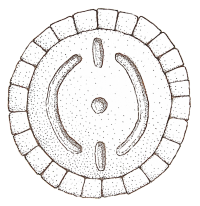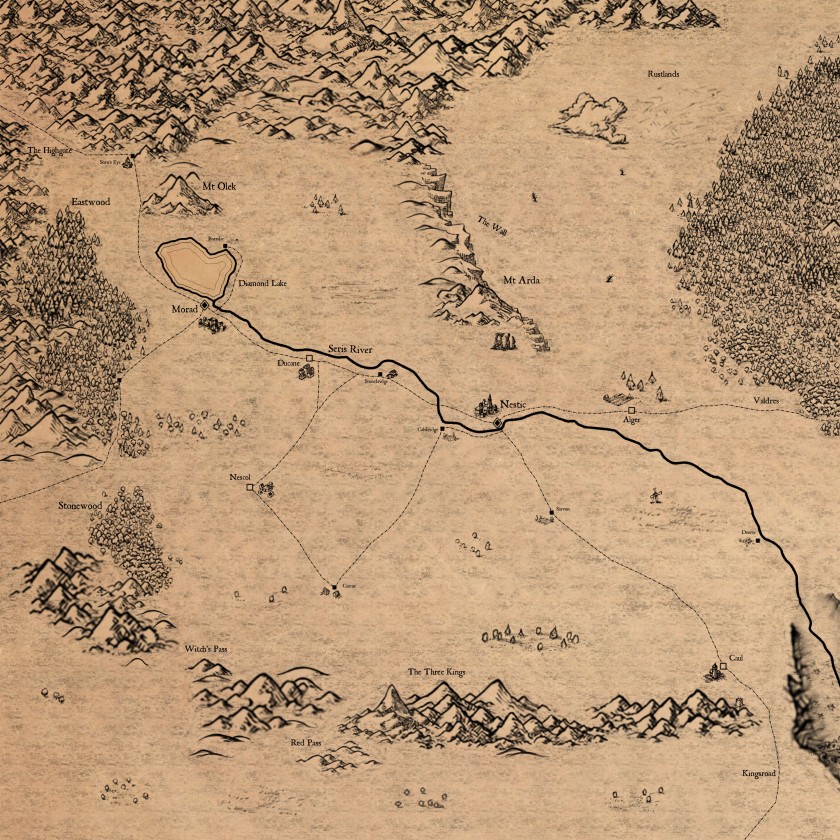Freemarch
Freemarch is a frontier, the last outpost of civilization and the church, the place where roads end. Beyond lies the frozen north of Vos and Breithdal, and to the east, the all-devouring forest of the Valdres.
It is also a crossroads where deep-delving Dwarves, Vosiri trappers, and treasure hunters mingle, all seeking southern gold for their wares. Year after year, there is less to go around.
It is a dangerous country; a hiding place for outlaws and rebels. In the hills, there live a people older than the old kingdom, who honor their gods with the blood of civilized people. Beasts and monsters dwell here, in places unconquered or abandoned by men. Marchmen may gather on churchdays, but they also remember the words and offerings of old, the rites which keep the night-things at bay.
History
The Old Kingdom of Aebor
Ages ago, before the rise of the Pearl Emperors, the Seris valley was not a mere march, but the heart of a great kingdom.
The land was called Aebor, from the old-speech for the constellation now called the Northcrown. The deeds of the kings of Aebor are the stuff of legends. It is said that they led their people out of the east, after the great flood; that they were friends of the Tormen, and enemies of the Southmen and the Vosiri. The kings of this time built no cities, but ruled from a castle built on Mount Arda, at the heart of their kingdom. The old kings were buried at the great temple of Poliad, for the holy mountain was not yet swallowed by the forest.
The Epic of Seimar's sons tells the story of the kingdom during the Second Age of Sorrow, when the world froze. King Seimar, as he lay dying, divided his kingdom and followers between his sons, Toriach and Morach. Toriach, the elder son, brave and stubborn, delved with his followers into the caves below the Dragonmounts, in search of the inner fire. Morach the Clever founded a stronghold atop the hotsprings beside diamond lake, and called the place Morad. Winter besieged the settlement, and terrible monsters rose up to threaten the weakened king: giants, thunderers, and dire-wolves. The winter lasted a generation, and it was Morach's children who stepped forth to reclaim the kingdom. Toriach and his followers were never seen again, though the children of Morach delved deep in search of their lost kin. The spring of the great thaw is marked as year 0 in the northern reckoning (23 years before the start of the imperial count of years).
The Dwarves first appeared in the years after the thaw, and the king swore friendship with them.
The last of the line of the old kings was Falrerk the Unlucky, thought to have been murdered by his usurper, the first of the Sorcerer Kings. They wielded dark powers stolen from the School of Arnis, and led Aebor against Tormar and Serulai in the War of the Torch. They abandoned the old gods, breaking menhirs and desecrating temples to appease new patrons. The last of them, Guirn the Cruel, was slain in battle against the Serulaians in 531; he was the last king of Aebor.
Their black dynasty lasted four generations; all but Guirn are entombed within Mount Olek, which is still sometimes called the Black Mountain.
Conquerors from the South
The kingdom was exhausted by the wars of the Sorcerer Kings. The Valdres-wood crept over the boundary stones in the east, swallowing first the holy mountain and then the eastern district. The hillmen, long suppressed, returned to ravage the outer settlements and exact a bloody vengeance. Most towns found what protection they could as vassals or clients to the lords of Serulai. Gloamingwatch, the castle of the first kings, was left a crumbling ruin.
With the southern rulers came southern priests, emissaries of the Church of the Authority. The lordly patrons built the first churches, tore down shrines and temples, and even built a monastery at the edge of Diamond Lake.
In 663, Serulaian patronage gave way to imperial rule. Work was begun on a new fortress at the south of the march, to secure the imperial frontier. The church was now backed with the strength of imperial law, though the region was largely spared the horrors of the great inquisition.
For a brief time, the March prospered; Imperial rule brought trade and investment along with its taxes and tithes.
This prosperity was not to last. Costly wars in the east drew gold away from the northern frontier. Thirty years of bloody civil war made things worse. The War of the Three Emperors was fought far from the March; mass conscription, famine, and finally rebellion brought the chaos home. By 759, the last of the imperial garrison had been siphoned off to fuel the conflagration, and the Lords of Morad fought with Serulai for control of northern trade. In 811, the last of the border forts fell to the northern army. After a long and bloody war, the March was free of the Empire and their Serulaian vassals.
The Dawning Age
It was not to be a happy peace.
The returning army brought back plague. For fifteen years, disease wracked the country. Trade ceased entirely. Crops rotted in the field as rich and poor alike died shivering in their beds. Some outlying villages died out entirely; others were simply abandoned by the survivors. Even today, eight years after the last deaths, many bear the pox-scars.
Many also noted a steady shift in the weather, a chilling which had contributed to the famines of the eighth century, and which was now almost certainly growing more severe.
Serulai, stricken earlier by the plague, and with a better climate, was faster to recover. In 825, the old bonds of patronage were revived. A powerful Serulaian lord rules the March as far north as Nestic; he has learned something from the Imperial bureaucrats so recently driven out of Serulai, and taxes as heavily as he can manage. North of Nestic, the March is "Free," but lawless might be a better term. The petty lords of the Seris bicker with each other, and look south with hatred.
And each passing winter is a little colder, a little longer than the last.
Important Places (WIP)
Morad, the Old Capitol
The city was founded by Morach the Clever on four low hills overlooking diamond lake. It was built in the days of the Good Kings and their champions; it suffered in the iron grip of the Black Dynasty; it was sacked by St. Garlaian the Redeemer.
The tallest of these hills bore a hotspring, which already held a shrine to Gasa. Today this hill is the Hightown; the old spring is a now a subterranean temple. The wall-houses, the oldest dwellings in Morad, rise 4 stories from street level to the top of the hill. Only Steep Street runs up to the King's square, winding up the hillside through two ancient gates. The Old Keep, the seat of Morach's heirs and now the council of stewards, overlooks the whole city. The Sorcerer Kings abandoned the keep as the royal seat (they ruled from the fortress Gloamingwatch), but they did greatly expand the dungeons beneath the keep, creating a prison called The Pit.
Sarlai Square (named for southern traders) holds the city's major market, and great merchant houses surround it in the district called Redgate (for the bloody battle when the conquering Saint Garlaian breached the city). The finest of the noble houses within the city surround the true civic center, the Old Square, which is not far from the Hightown gates, in a district called the Blue Quarter. Three other, smaller squares can be found within the walls, including St. Rislan's Square, known more often as the Witchmarket. Hedge mages, witches and druids gather here once a month, offering their services and peddling numberless trinkets, talismans and amulets.


No Comments